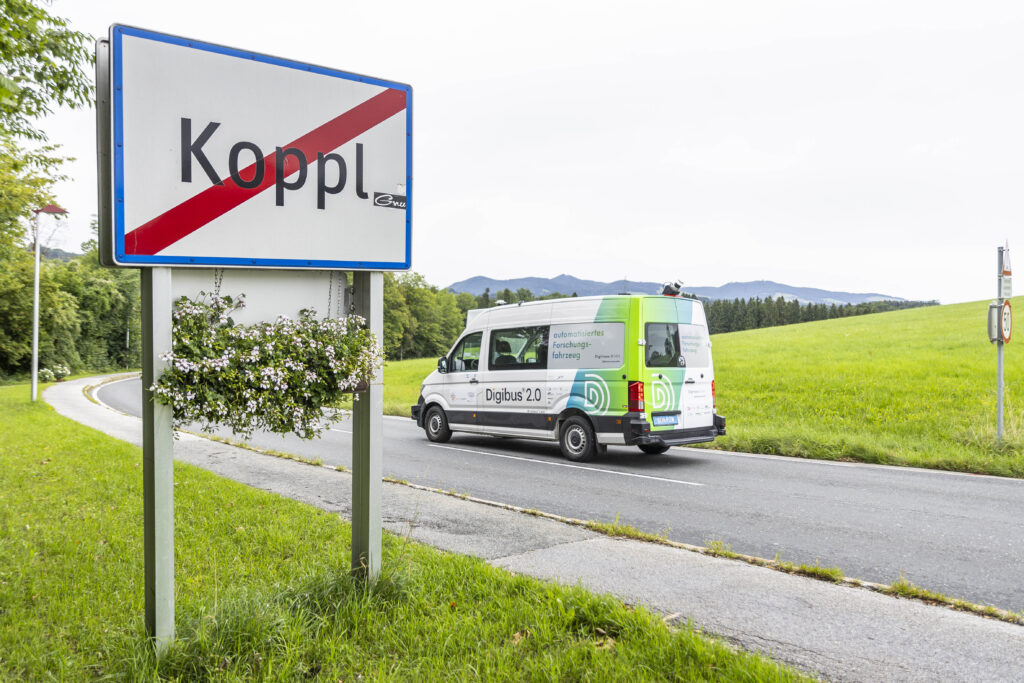
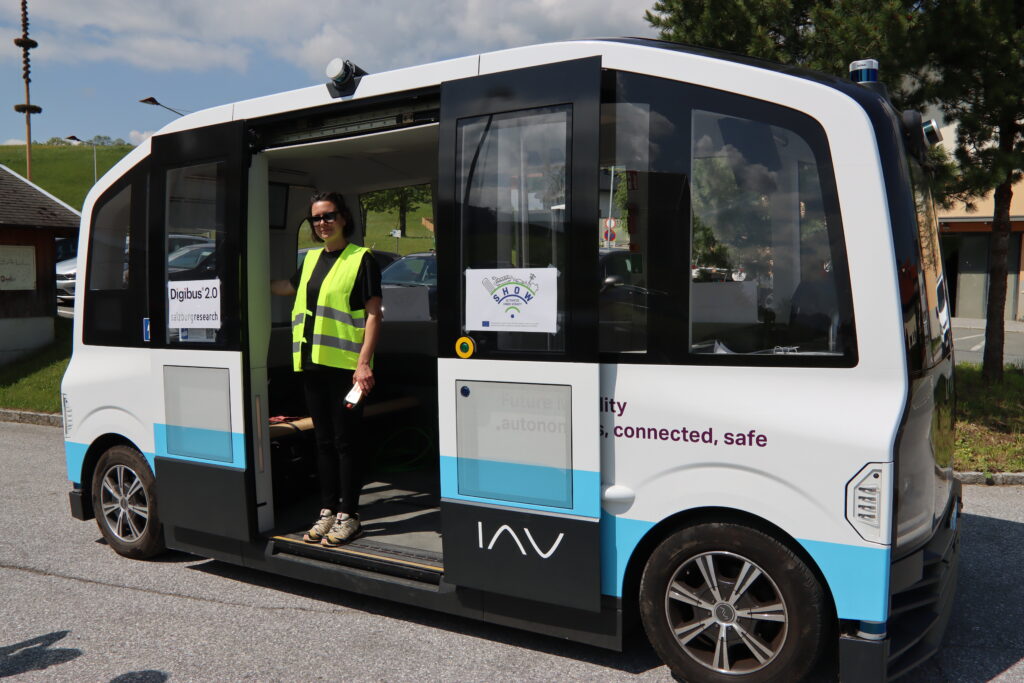
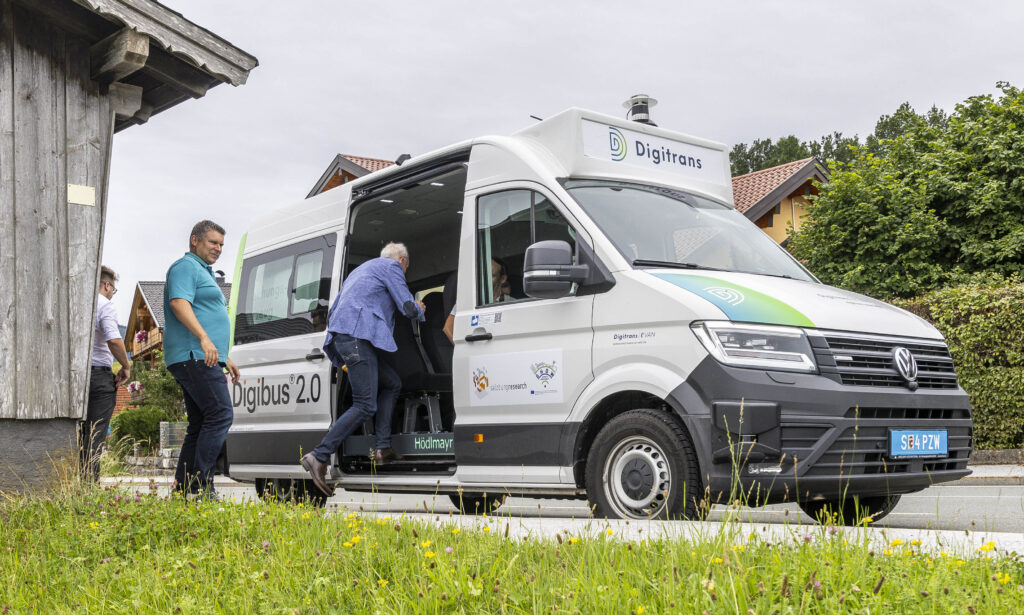
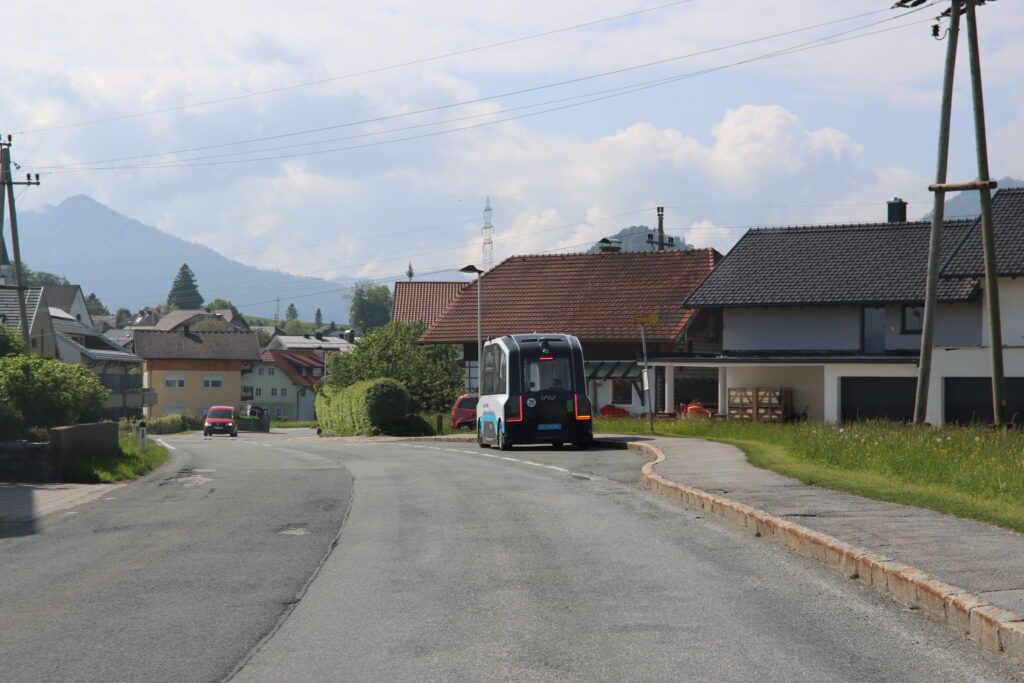
Impressions from the pilot operation in Koppl with the two automated vehicles. Left: the DigiTrans eVAN as the new “Digibus® 2.0”; Owner DigiTrans eVAN: DigiTrans GmbH; Right: HEAT-Shuttle © Salzburg Research
As part of the European research project SHOW, Salzburg Research, together with partners, investigated how highly automated shuttles can be deployed under real conditions in public road traffic. The aim was to evaluate technological maturity, operational feasibility, and public acceptance.
Test Environment and Framework Conditions
The pilot route for the highly automated shuttles was located in the municipality of Koppl in the province of Salzburg. It covered a route of approximately 1.4 kilometers, connecting the town center with the stop “Sperrbrücke.” In total, four stops were set up in each direction. The road is asphalted, slightly curved, and has a maximum gradient of 8 % —a challenging environment that provided important insights for practical operations.
In addition, a C-ITS corridor was established along the B158 Wolfgangsee federal highway. Cooperative applications were tested here, such as traffic light prioritization and the transmission of warning messages to other road users.
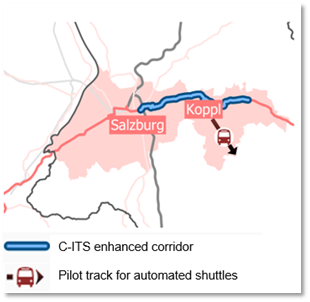
Two different vehicle types were used:
- an automated shuttle (prototype HEAT-Shuttle)
- an automated research vehicle (Digitrans eVAN)
Operation took place on weekdays from Monday to Friday and was free of charge for passengers. Trained safety operators accompanied the vehicles to intervene if necessary and thus ensured passenger safety.
The project pursued several key objectives:
- Enable safe and sustainable transport
- Integrate highly automated shuttles into existing mobility services
- Testing new technologies in real road traffic
- Gather experience for use in rural and peri-urban regions
- Increase public acceptance through direct user experience
Key Findings
Technical Aspects
The pilot operation showed that highly automated vehicles are already operational in complex traffic situations—though with limitations. Localization and positioning proved to be particularly challenging. In built-up areas with many reference points, the systems worked reliably; in less structured environments, however, orientation problems occurred.
In addition, more complex driving maneuvers such as left turns at unsignalized intersections or leaving bus stops repeatedly required manual intervention by the safety drivers.
Battery performance was also a limiting factor: gradients, weather conditions, and passenger load led to higher energy consumption, requiring intermediate charging. For future operations, more advanced battery systems or adequate charging infrastructure along the routes will therefore be essential.
In addition, the internal operation of the automated vehicles – for example, the sensitivity of steering and braking systems—proved to be a specific issue, requiring targeted training for safety operators.
Info Box: Key Insights at a Glance
- Automated shuttles have proven operational capability, though further technological optimization is required.
- Safety and reliability are the key success factors.
- Accessibility in vehicles and at stops is essential.
- Charging infrastructure along the routes must be available.
Operational Experience
The pilot further revealed that reliability and safety are the decisive factors for success. Passengers approach new technologies with curiosity, but in the long term, dependability is paramount: punctual, safe, and trouble-free journeys are decisive for acceptance.
Regular safety checks of the route as well as daily test drives in autonomous mode proved necessary to ensure stable operations. In addition, weather and road conditions must be taken into greater account—heavy rain, snow, or fog can push automated systems to their limits.
User Experience
The public response was positive overall. Many citizens took the opportunity to experience the technology firsthand. Particularly noticeable was the strong interest shown by children, young people, and older people. A common request was for more information during the journey, such as vehicle status or upcoming maneuvers.
The importance of accessibility was also emphasized: to ensure automated shuttles are available to everyone, stops and vehicles must be designed to be consistently barrier-free.
Potential for Public Transport
The pilot demonstrated that highly automated shuttles hold great potential, especially as first-/last-mile solutions. They can meaningfully complement existing public transport, particularly in rural areas or during off-peak hours such as evenings, early mornings, or weekends. In this way, mobility gaps can be closed, private car use reduced, and local emissions lowered.
However, several conditions must be met for such services to be widely implemented:
- Further technological development to increase maturity and safety
- Operating costs comparable to conventional vehicles
- Adaptation to topographic conditions such as gradients
- Seamless integration into existing public transport fare and booking systems
Outlook
Participation in the SHOW project has significantly strengthened Salzburg Research and its partners in their expertise for the introduction of automated mobility. The insights gained will feed into future projects and will be made available to national and European decision-makers.
In addition, the experiences will be incorporated into the work of the Strategic Alliance for Automated Mobility (SSAM Austria), which has been promoting exchange between relevant stakeholders since 2023 and strengthening their position in the field of automated mobility.
In the long term, it is expected that automated shuttles—initially with safety operators, later fully driverless—will take on a permanent role in public transport. In particular, rural regions stand to benefit from new possibilities for more sustainable, flexible, and inclusive mobility.
Info Box: A Look Ahead
- Automated shuttles are already a reality today – albeit still with safety operators.
- Between 2030 and 2040, according to EU roadmaps, technological maturity is expected.
- Requirements: clear legal frameworks and consistent further development.
Conclusion
The pilot operation in Koppl has demonstrated that automated shuttles can already be deployed on public roads, even if further development is needed before large-scale application. The experiences from Koppl provide a valuable foundation for shaping the path toward future-oriented, safe, and climate-friendly mobility.
A special thanks goes to all citizens who accompanied the pilot operation, tried it out, and enriched it with their feedback—as well as to the employees of the municipality of Koppl for their continuous support.
Digibus® is back on track
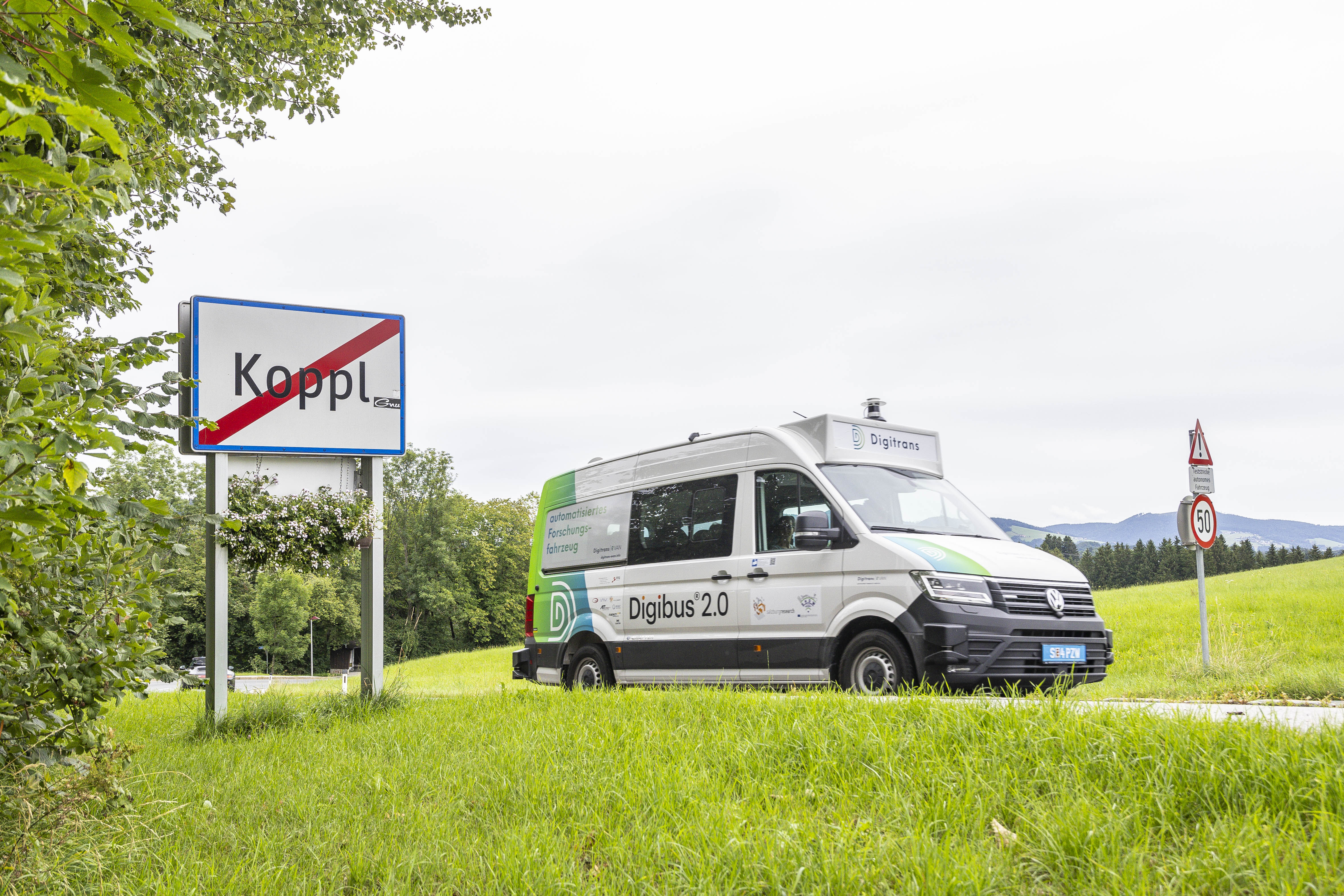
The Digitrans eVAN as the new “Digibus 2.0” in the Salzburg municipality of Koppl as part of the European research project SHOW; owner DigiTrans eVAN: DigiTrans GmbH, © Salzburg Research, wildbild
Based on experience from the flagship project DIGIBUS ® AUSTRIA, automated passenger transport is tested for connecting a peri-urban area to an intermodal mobility hub. The self-driving vehicle – Digibus® 2.0 – is, like its predecessor, offering a bus route in the municipality of Koppl (Salzburg). These public demonstrations are free of charge and can be used by commuters, tourists, day trippers and anybody interested in innovative transportation methods.
Pilot phase Il with the Digitrans eVAN
For this pilot phase, starting at the beginning of August 2023, a standard VW e-Crafter was equipped with additional sensor systems and software to be retrofitted into a self-driving research vehicle. In addition, the vehicle is able to communicate with the roadside infrastructure (roadside units) by means of an onboard unit. This communication method is known as V2X-communication (vehicle to everything communication) with the goal to increase traffic safety and to enable a more efficient control of public transport.
The shuttle will run five days a week according to a fixed timetable, complementing the already existing public transport solution, shortening the cycle time to half an hour. The timetable is aligned with the arrival and departure times of the buses, which will be transporting the passengers to Salzburg or Bad Ischl. As with previous public demonstrations, it is mandatory that a trained safety operator will be on board, who will monitor the operation of the vehicle and can intervene at any time.

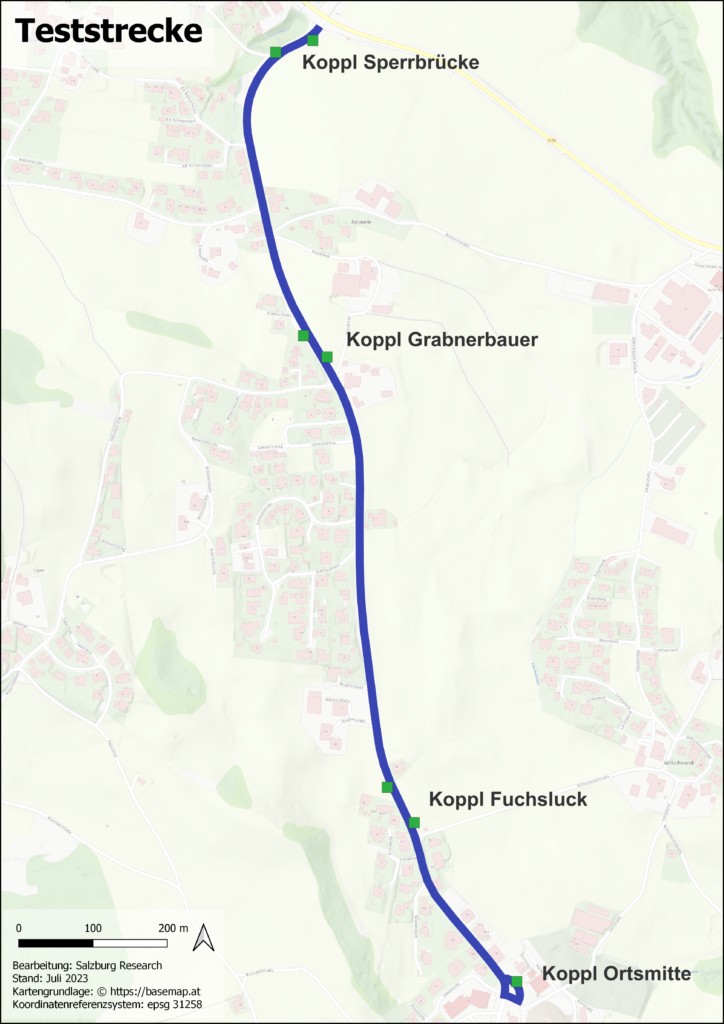
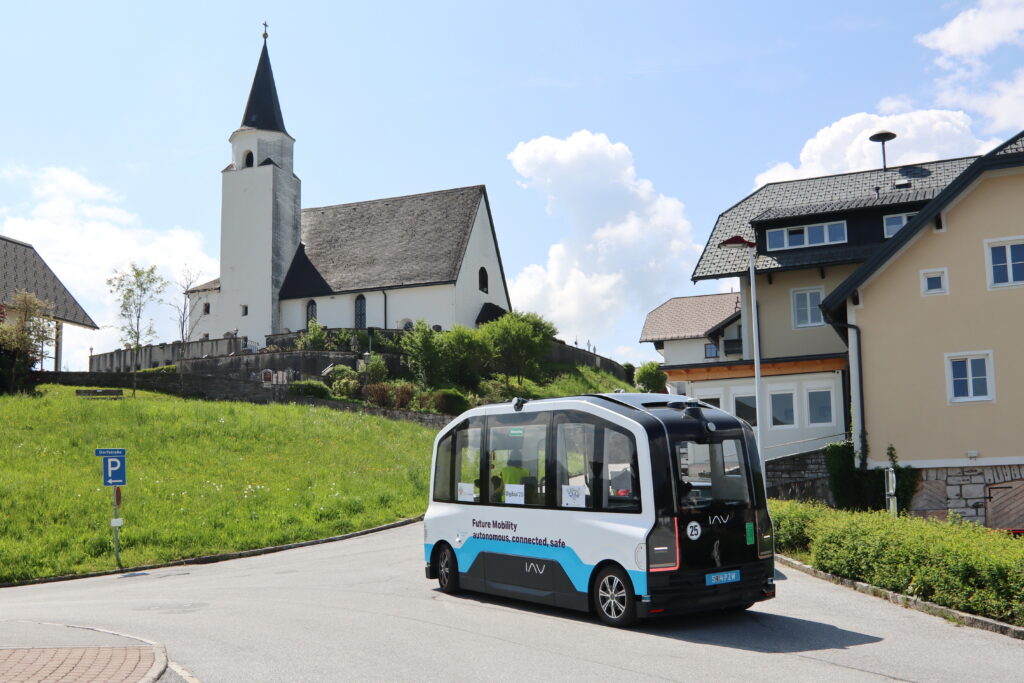
Pilotphase I with the HEAT-Shuttle: 15th of May – 20th of June 2023
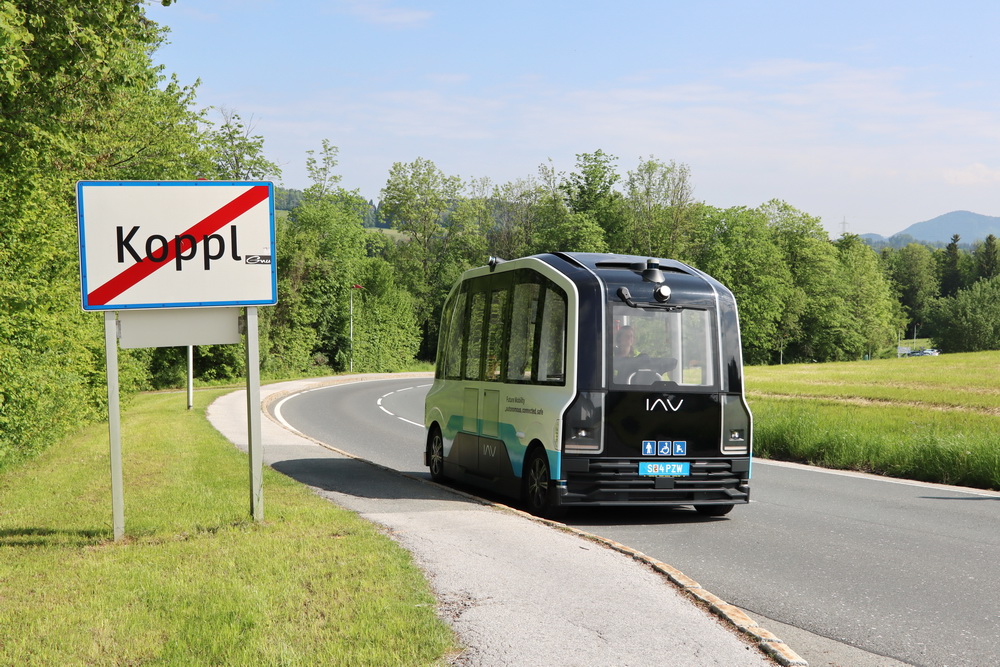
A pilot operation with the HEAT-Shuttle took place from Monday to Friday from 15th of May until 20th of June 2023 (except public holidays).
An acceptance survey was conducted and revealed that the passengers were very pleased. The test track continues to be demanding and complex due to its inclination, the weather situation and the localization accuracy.
Acknowledgements
Salzburg Research conducts this demo operation within the European research project “SHOW – SHared automation Operating models for Worldwide adoption“. SHOW aims to explore the deployment of electric, connected and automated fleets for passenger transport and for logistics in (peri-)urban environments in Europe. The European Union in the course of the Horizon 2020 Research and Innovation Programme (Grant Agreement Nr. 75530) funds the project SHOW. Detailed results reports are available for download at the following link: https://show-project.eu/media/deliverables/
The research vehicle “Digitrans eVAN”, that runs in Koppl as the Digibus® 2.0, is provided by DIGITRANS GMBH for Austrian research activities. It is funded by the Austrian Federal Ministry for Climate Action via the Austrian Research Promotion Agency.
Kapsch TrafficCom AG is in charge of this infrastructure and the realization of C-ITS (Cooperative Intelligent Transport Systems)-services.

